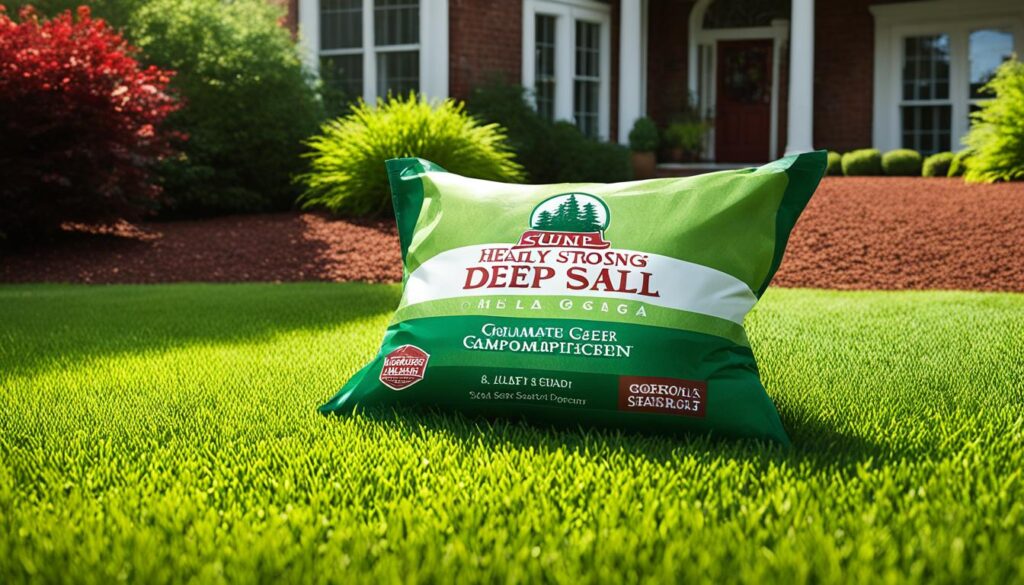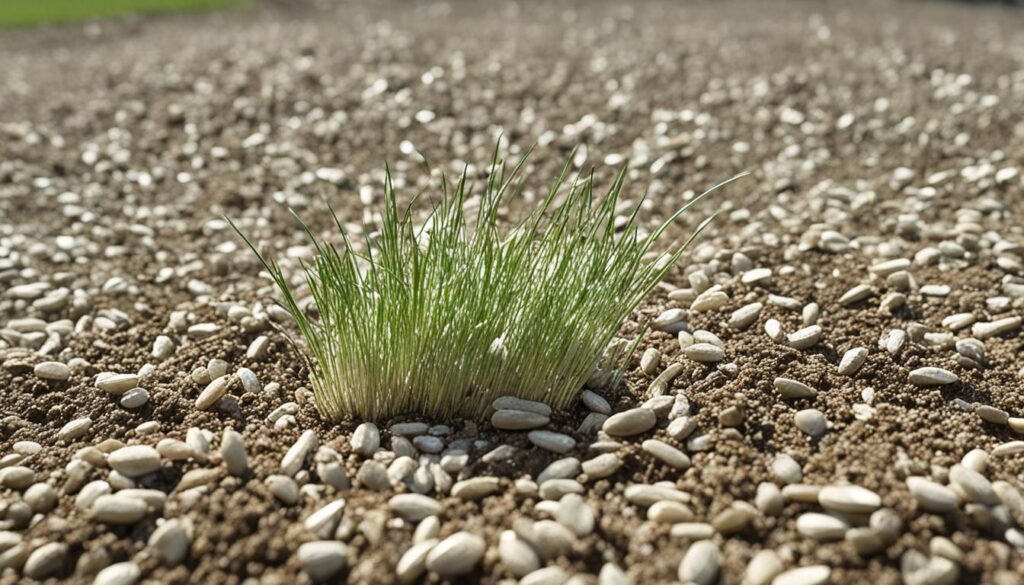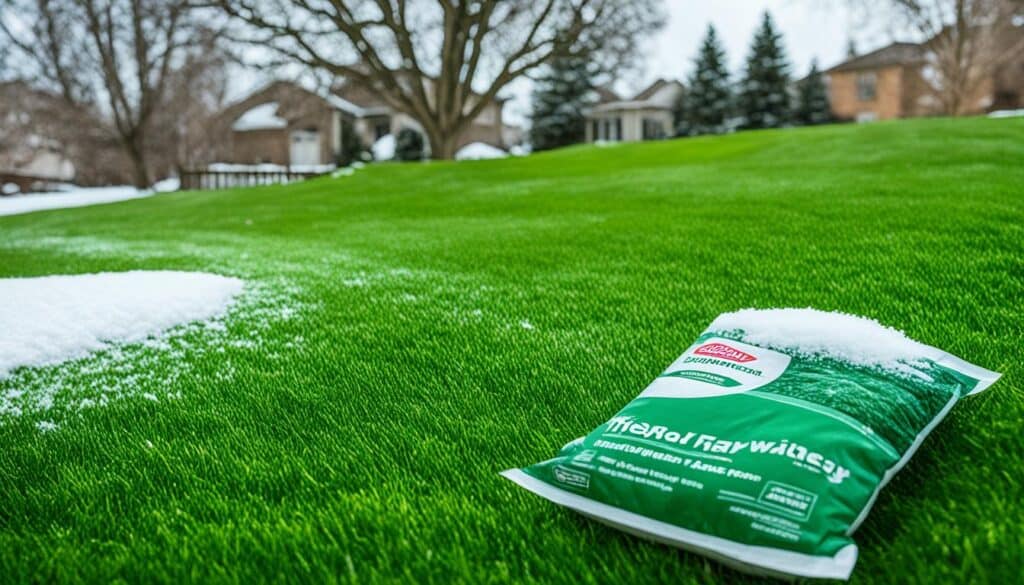Did you know 60% of Georgia’s soil is red clay? This fact shows the challenge of growing a lush lawn in Georgia. Finding the right grass seed for Georgia red clay can change your landscaping game.
Georgia’s warm and humid climate is perfect for a vibrant lawn all year. But, the red clay soil makes it harder. The secret is picking grass seeds that do well in this soil.
When picking grass seed for Georgia’s red clay, think about sun, foot traffic, and what you like. This article will look at different grass types for Georgia’s red clay soil. We’ll cover both warm-season and cool-season grasses to help you choose the best for your lawn.
Whether you’re starting a new lawn or fixing an old one, knowing the best grass seed for Georgia red clay is key. We’ll talk about different grass types, how they handle Georgia’s climate, and what care they need. This way, your lawn will do well in tough soil.
Key Takeaways
- Warm-season grasses are generally more suitable for Georgia’s climate
- Bermudagrass varieties like Oasis and Yukon are popular for full-sun areas
- Centipede grass is low-maintenance and adapts well to low fertility soils
- Tall Fescue is a cool-season option for mountain and upper piedmont regions
- Consider factors like sunlight, water availability, and foot traffic when choosing grass seed
Understanding Georgia’s Red Clay Soil
Georgia’s red clay soil is a challenge for grass growth. It’s common across the state, affecting lawn care from the Piedmont to the Coastal Plain. Knowing how to handle it is key to growing a healthy lawn.
Characteristics of Red Clay Soil
Red clay in Georgia has poor drainage and compacts easily. It often lacks nutrients, making it hard for grass seeds to grow strong roots. The dense soil also makes it hard for roots to penetrate, hurting lawn health.
Challenges for Grass Growth in Red Clay
Growing grass in red clay is hard. The soil’s poor drainage leads to too much water in wet times and too little in dry times. This stress can cause patchy lawns. The soil also gets compacted, which stops air and nutrients from reaching the grass.
Soil Preparation Techniques
To make your georgia grass clay soil better, try these steps:
- Aerate the soil to improve drainage and reduce compaction
- Add organic matter to enhance nutrient content and soil structure
- Adjust soil pH to suit your chosen grass type
- Consider topdressing with compost or sand to improve texture
| Grass Type | Best Soil pH | Adaptation to Red Clay |
|---|---|---|
| Tall Fescue | 5.5 – 6.5 | Moderate |
| Bermudagrass | 6.0 – 7.0 | Good |
| Zoysiagrass | 6.0 – 6.5 | Very Good |
| Centipedegrass | 5.0 – 6.0 | Good |
By understanding and tackling Georgia’s red clay soil, you can grow a strong lawn. This lawn will do well in the state’s varied climate.
Warm-Season vs. Cool-Season Grasses for Georgia
Georgia’s climate is perfect for both warm-season and cool-season grasses. Your choice depends on where you live and how you care for your lawn. Warm-season grasses do well in the summer heat and sleep through winter. Cool-season grasses grow best in spring and fall but can’t handle extreme heat.
Bermudagrass is a top choice for those looking for heat-tolerant grass in Georgia. It’s also drought-resistant and uses less water. This grass is often used in the Piedmont and Coastal Plain for pastures and hay.
Cool-season grasses like Tall Fescue are great for Georgia’s Piedmont Region. They need more water, especially when it’s hot. Tall Fescue should be cut between 2 to 4 inches tall.
| Grass Type | Best Region | Characteristics |
|---|---|---|
| Bermudagrass | Piedmont, Coastal Plain | Heat tolerant, drought resistant |
| Tall Fescue | Piedmont, shaded areas | Cool-season, shade tolerant |
| Bahiagrass | Coastal Plain | Warm-season, low maintenance |
For drought tolerant grass georgia lawns, think about Zoysia or Centipedegrass. These grasses need less water and are easy to maintain. On the other hand, cool-season grasses like Tall Fescue stay green all year but need more care in the summer.
“The gap between the best, better, and good turf-type tall fescue cultivars has narrowed in the last 15 years.”
Your choice of grass affects your lawn care. Warm-season grasses use less water but may turn brown in winter. Cool-season grasses stay green longer but need more care in the summer. Think about your specific needs and the climate in your area when picking the best grass for you.
Best Grass Seed for Georgia Red Clay: Top Picks
Finding the right grass seed for Georgia’s red clay soil can be tough. Let’s look at some top picks that do well in this tough environment.
Bermudagrass: Heat and Drought Tolerant Option
Bermuda grass is a top choice in Georgia for a reason. It’s great at handling drought and the hot summers. It grows up to 16 inches tall, making it great for busy areas. But, it needs regular care and lots of water.
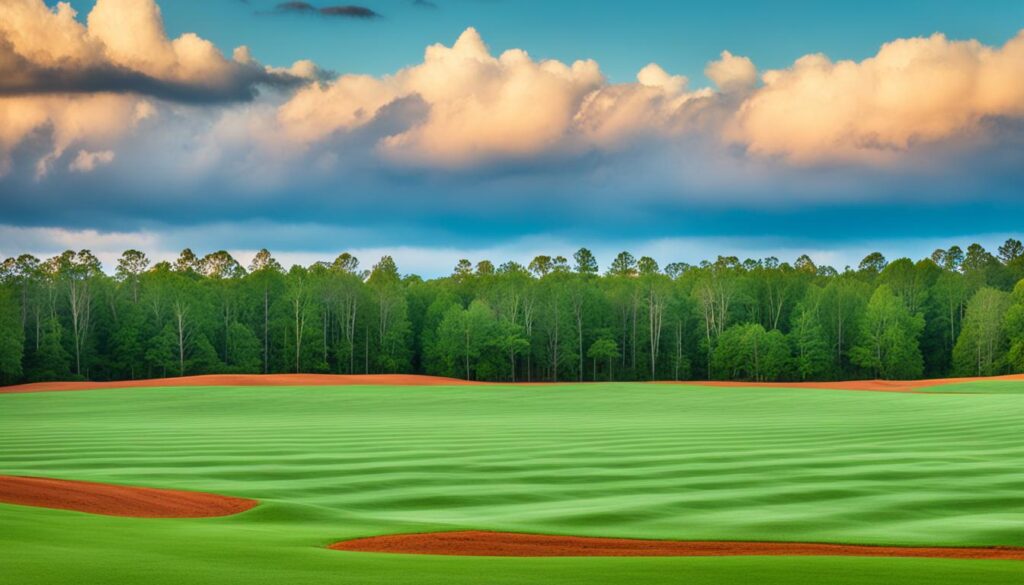
Zoysia: Durable and Salt-Resistant Choice
Zoysia grass is strong and works well on different soils, including red clay. It’s heat and drought resistant, and fights weeds. If you want a low-care lawn that can take some foot traffic, this is it.
Centipedegrass: Low-Maintenance Solution
Centipedegrass is perfect if you don’t want to spend a lot of time on lawn care. It can handle some shade and is very drought resistant. It grows slowly but recovers well, ideal for those who like a laid-back lawn care routine.
Tall Fescue: Cool-Season Alternative
In northern Georgia, tall fescue is a great choice for cool-season grass. It’s very drought tolerant and easy to maintain. It can grow fast in the fall, giving you a lush lawn. It fits well in both sunny and shady spots, making it versatile for any landscape.
| Grass Type | Water Needs | Drought Tolerance | Maintenance |
|---|---|---|---|
| Bermudagrass | High | High | Moderate to High |
| Centipedegrass | Low to Moderate | High | Low |
| Tall Fescue | Medium to High | Excellent | Low |
Planting and Maintenance Tips for Red Clay Soil
Growing a lush lawn in Georgia’s red clay soil can be tough. The key to success is using the right planting methods and ongoing care. Let’s look at some key tips for growing grass in clay-rich areas.
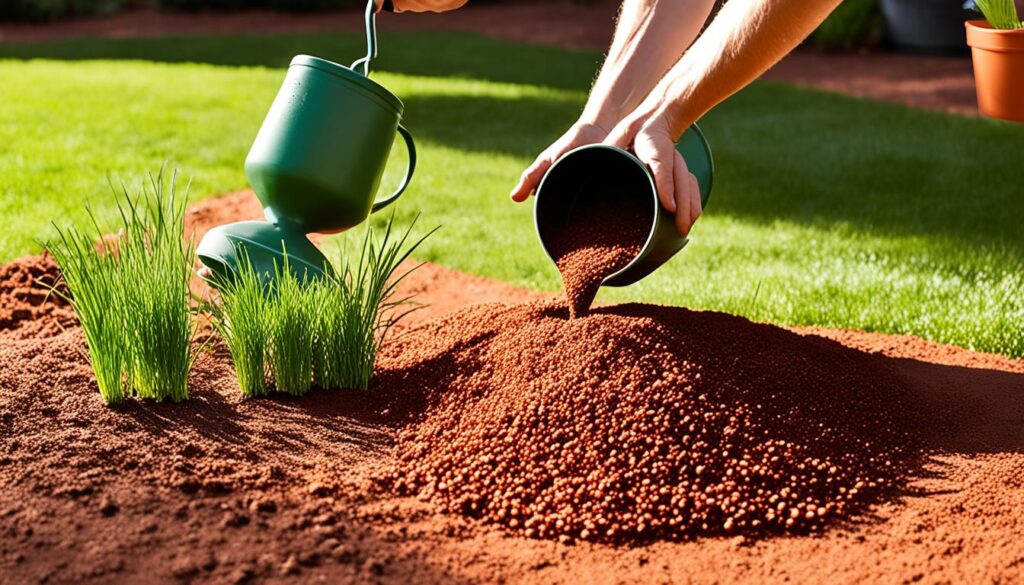
Getting your soil ready is key when planting grass seed in Georgia’s red clay. Start by removing about 12 inches of clay soil. Then, till in a 2- to 4-inch layer of compost to a depth of 6 inches. This helps create air pockets for roots to grow well. For better results, add river sand and peat moss to improve drainage.
When picking grass seed for Georgia’s red clay, choose varieties that do well in clay. Top Choice Tall Fescue is a great choice, known for its toughness in tough soils. Spread the seeds as the package suggests, splitting the amount for even coverage.
Watering is crucial for seed germination. Keep the soil moist with regular, short watering sessions. Most grass seeds will start to grow within two weeks, but some may take longer. Once the grass is 3 inches tall, you can start mowing it lightly.
“The secret to a thriving lawn in clay soil is patience and consistent care. With the right approach, you can transform your red clay into a green oasis.”
Keeping up with regular maintenance is vital for a healthy lawn. Aerate once a year to reduce compaction and help roots grow. About four weeks after germination, give your new grass a high-nitrogen fertilizer. For specific care, consider soil testing to find out what your lawn needs.
| Task | Frequency | Benefits |
|---|---|---|
| Aeration | Annually | Reduces soil compaction, improves root growth |
| Fertilization | 4 weeks post-germination, then as needed | Provides essential nutrients for grass growth |
| Mowing | When grass reaches 3 inches | Promotes dense growth, maintains lawn health |
| Soil Testing | Annually or bi-annually | Helps tailor care to specific soil needs |
By following these guidelines, you’ll be on your way to a beautiful lawn in Georgia’s red clay soil. Remember, patience and consistent care are key to success.
Improving Soil Quality for Optimal Grass Growth
Growing grass in Georgia’s red clay soil can be tough. To get a lush lawn, focus on making the soil better. This means adding soil amendments, watering right, and choosing smart fertilizers.
Soil Amendments for Red Clay
For red clay lawn seed in Georgia, the right soil changes make a big difference. Adding things like compost or manure can really help. For instance, one gardener added 10 trailer loads of sheep manure and planned 30 loads of horse manure to make their clay soil better.
This made the soil easier to work with, helped with drainage, and let air in.
Proper Watering Techniques
Watering your grass in georgia clay soil is key. Water deeply but not too often to help roots grow deep. This makes your lawn stronger against drought. One gardener even used 1000kg of water in their BMW to help their lawn.
Remember, clay soil holds water well, so don’t overdo it.
Fertilization Strategies
Fertilizing red clay soil needs careful planning. Start with a soil test to see what nutrients you need. Then, use a slow-release fertilizer that’s right for your grass type.
For clay soils, think about using organic fertilizers. They help the soil and feed your lawn.
- Use compost as a natural fertilizer
- Apply fertilizer in spring and fall
- Avoid over-fertilizing to prevent runoff
By following these steps, you’ll make your georgia grass clay soil perfect for your lawn. Remember, it takes time to improve soil quality. But, the effort pays off for a better lawn.
Conclusion
Choosing the best grass seed for Georgia red clay is important. With the right seed and care, your lawn can flourish. Warm-season grasses like Bermudagrass and Zoysiagrass work well. Cool-season grasses like Tall Fescue are good for different conditions.
Getting your soil ready is key when dealing with red clay. Testing your soil can show what it needs for pH and nutrients. Many people do well with grass seed mixes made for clay soils. Fine fescue and Kentucky bluegrass are popular choices.
Keeping your lawn healthy is crucial. Use the right amount of seed and starter fertilizer as suggested. For shady spots, adjust your mowing height and cut back on fertilizer. With the right steps, you can make your Georgia red clay lawn look great.
FAQ
What are the characteristics of red clay soil in Georgia?
Red clay soil in Georgia has poor drainage and gets hard when compacted. It often lacks nutrients, making it tough for grass to grow and spread.
What is the difference between warm-season and cool-season grasses?
Warm-season grasses like Bermudagrass, Zoysiagrass, and Centipedegrass love the summer heat and sleep through winter. Cool-season grasses, such as Tall Fescue, do well in spring and fall but can’t handle extreme heat.
What are the best warm-season grass options for Georgia’s red clay soil?
Bermudagrass is great for hot weather, doesn’t need much water, and is perfect for busy spots. Zoysiagrass is tough, fights salt, and grows well on different soils. Centipedegrass is easy to care for and likes acidic soils.
What is a good cool-season grass option for Georgia’s red clay soil?
Tall Fescue is a cool-season grass that works well in northern Georgia. It handles both sun and shade.
How can I prepare red clay soil for grass planting?
To get red clay soil ready for grass, start by aerating it. Then, add organic stuff and fix the pH to help with drainage and structure before planting.
What are some soil amendments for improving red clay soil?
Using compost, sand, and gypsum can make red clay soil better. They help with structure and drainage.
How should I water and fertilize grass in red clay soil?
Water your grass deeply but not too often to help its roots grow deep in red clay. When fertilizing, use soil tests and think about what your grass type needs.

